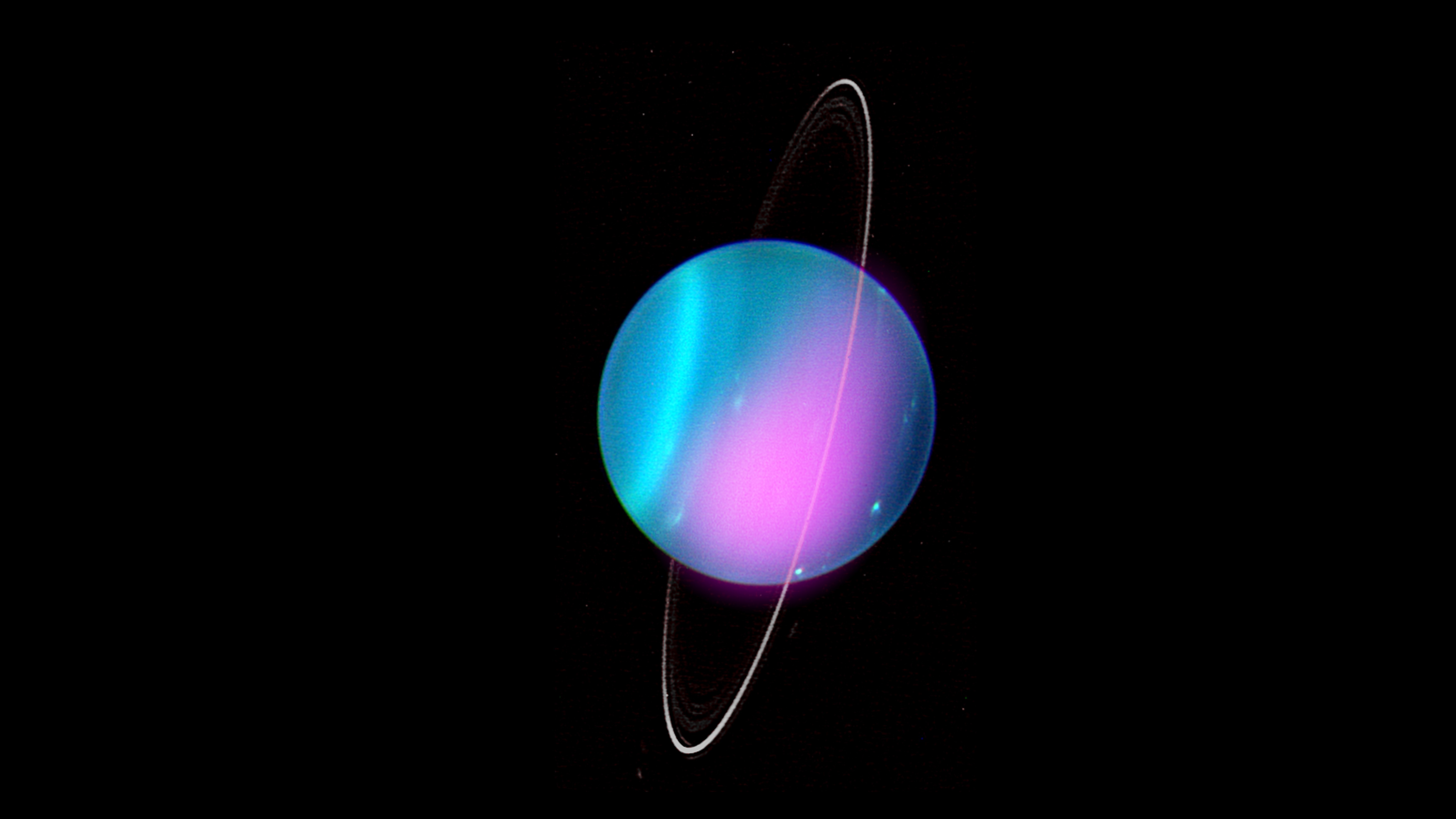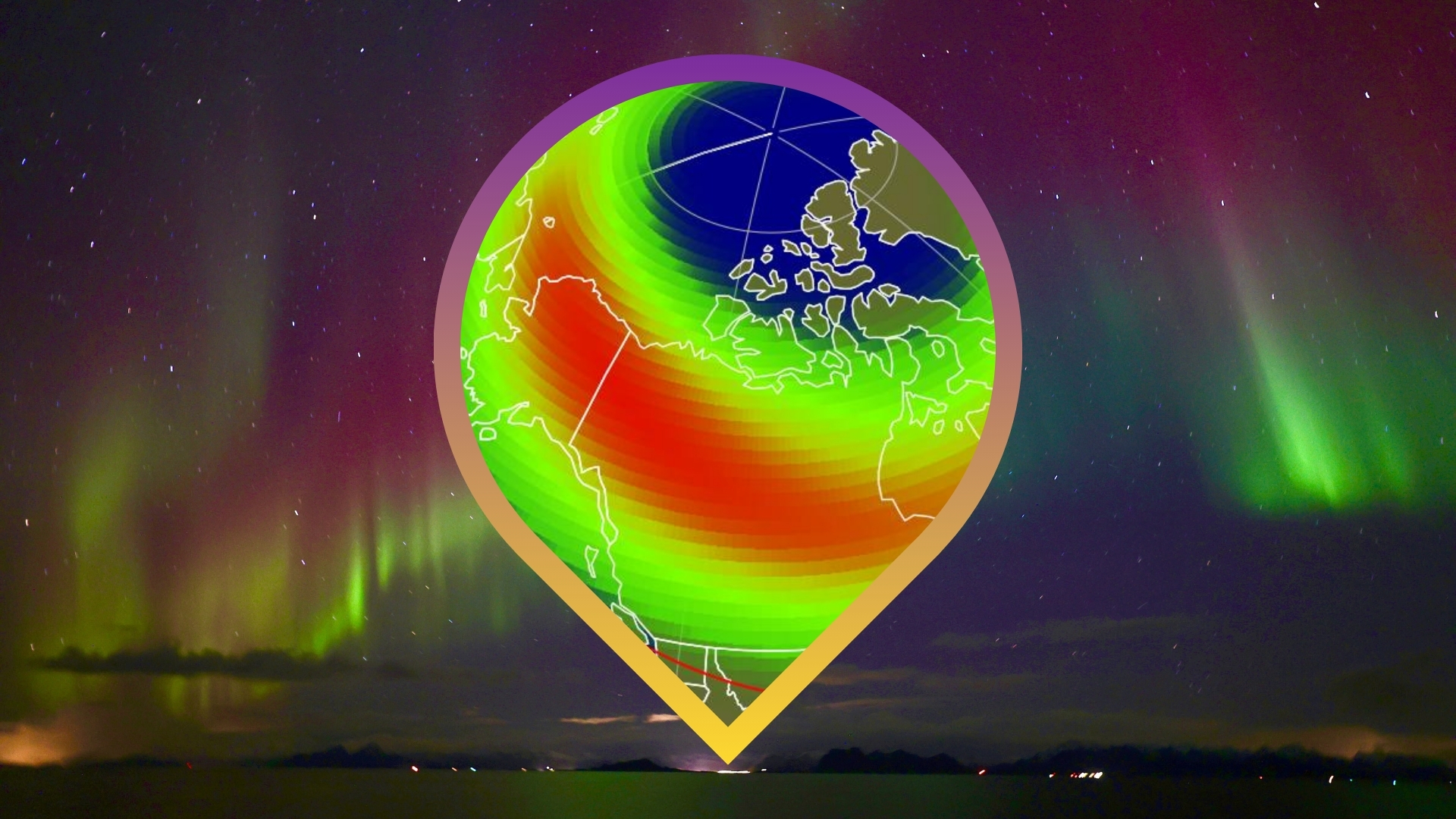Uranus' weird tilt may be the work of a long-lost moon

Uranus is just plain weird, and one of the weirdest things about it is its tilt.
Uranus has the largest tilt in the solar system, at 98 degrees, which means it spins almost perfectly perpendicular to the direction of its orbit. Astronomers have long suspected that a series of giant impacts early in the planet's formation did the job of flipping Uranus on its side, but new research suggests a much less violent cause: a satellite of Uranus that wandered away.
All the planets of the solar system have orbital tilts less than 30 degrees — except Uranus. The whole Uranus system is flipped onto its side, affecting not just the planet's rotation but also its rings and moons, too, which orbit around the planet perpendicular to the planet's motion around the sun.
Related: Photos of Uranus, the tilted giant planet
The odd tilt of Uranus is especially weird considering that the neighboring ice giant, Neptune, has a normal tilt despite the two likely sharing similar formation histories. So what went wrong for Uranus?
Astronomers have long suspected that at least one giant impact occurred when Uranus was forming. It's easy enough to imagine: The right collision at the right time would deliver enough energy to push Uranus over while it was still in its protoplanetary stage, and the planet never picked itself back up before forming its system of planets and moons.
And scientists have some evidence to support this picture. The solar system was a rather violent place in its youth, so there are plenty of large rocks around to wreak havoc. And Neptune does display slight differences, such as a different temperature and a set of moons with different characteristics (like Neptune's being much larger), indicating the two planets experienced distinct conditions at some point in their formation.
Breaking space news, the latest updates on rocket launches, skywatching events and more!
The unluckiest planet
But the impact hypothesis has weaknesses, too.
There wasn't just one large rock whizzing around the early solar system looking for an unlucky target — there were many. All the planets, especially the outer ones, likely suffered many collisions during their formation. Even the inner planets weren't spared; Earth got smacked by a Mars-size protoplanet early on, forming the moon.
So if Uranus got hit hard enough to tip it over, why didn't the other planets? Jupiter and Saturn eventually developed thick clouds of gas, which could, over time, have gotten them upright again. But Neptune had a similar history to Uranus, and despite their small differences the two ice giants are extremely alike: they have similar atmospheres, both have tangled magnetic fields, and have similar sizes, masses and spin rates.
We're left with a dilemma. Perhaps poor Uranus was just extremely unlucky — and there are simulations that support the idea of just the right impact tilting the world. But "pure luck" doesn't really satisfy the typical astronomer; we should exhaust all the other options before resorting to it.
So perhaps the answer doesn't have anything to do with impacts. Perhaps it has to do with moons, as a team of scientists propose in a new paper accepted for publication in the journal Astronomy and Astrophysics and posted to the preprint site the arXiv.org.
Lost children
The early solar system did not look much like the solar system of the present day. The giant planets in particular probably formed much closer together and much closer to the sun. Over time, interactions among them and with wandering planetesimals outward, with Uranus and Neptune migrating the farthest. (In fact, some models of the solar system even predict the existence of a fifth massive planet that got ejected during all this migration.)
Each of the giant planets formed with a collection of moons, but those moons got reshuffled as the planets migrated. With all the complicated gravitational dynamics going on, some planets lost moons while others gained new ones.
So Uranus, could have been born with or quickly captured a massive moon. And if the moon was big enough, it could have started playing games with the planet's spin.
Uranus likely started out with a random but small tilt. Over time, that tilt will precess, as astronomers call it, with the direction of the planet's rotation wobbling like a gigantic top. (Earth does the same thing.) Usually, a moon doesn't care about its planet's precession of tilt. But it's possible for a moon to get locked into a resonance pattern, in which the length of time needed to precess matches up with a whole number of orbits of the moon.
This resonance allows the gravitational force of the moon to gently tug on the planet, reinforcing the precession. It's like an invisible string attached to the top of the planet: Over the course of millions of years, that tilt gets worse and worse. As this goes on, the moon's orbit would creep steadily closer to the planet.
The researchers found that if Uranus once had a large enough moon, it would, within a few hundred million years, be capable of pulling the planet's tilt over 80 degrees. To finish the job, the satellite would then crash into Uranus, locking the planet's tilt at its present value.
This scenario would explain why Uranus is so unique: it just had a large enough moon, which is common enough, that slipped into resonance — not so common that we should expect the same to happen to Neptune. And then it all went sideways from here.
Follow us on Twitter @Spacedotcom and on Facebook.

Paul M. Sutter is a cosmologist at Johns Hopkins University, host of Ask a Spaceman, and author of How to Die in Space.

